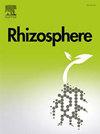Phenological shifts drive rhizosphere microbial community dynamics in Subtropical woody bamboo (Chimonobambusa utilis (Keng) P. C. Keng): pH and total phosphorus as main drivers
IF 3.4
3区 生物学
Q1 PLANT SCIENCES
引用次数: 0
Abstract
As a high-value clonal plant with rapid reproduction and growth characteristics, the relationship between the phenology of bamboo and the changes in rhizosphere microbial communities is still in its infancy. Here, we explored the change trends of composition and structure of rhizospheric microbial communities at key phenological stages in a medium-mountain woody bamboo Chimonobambusa utilis (Keng) P. C. Keng stands. This study employed Illumina high-throughput sequencing of 16S and ITS fragments to examine the dynamic changes in rhizosphere microbes from the dormancy stage to the shooting stages of Ch. utilis, as well as their relationship with soil physicochemical properties. Ch. utilis rhizosphere microbes had greater numbers of operational taxonomic units (OTUs), higher α-diversity, more complex and stable microbial community structure during the shooting stage, with more keystone species including Arthrobacter, Leohumicola, Sarocladium, etc. Moreover, rhizosphere microbes at the dormancy and shooting stages exhibited different preferences for soil physicochemical properties, and particularly soil total phosphorus (TP) demonstrated a more significantly positive correlation with rhizosphere microbes at the shooting stage. This study reveals the dynamic changes of rhizosphere microorganisms in different growth stages of subtropical bamboo, highlighting the significant impact of soil pH and TP on the composition of rhizosphere microorganisms during the bamboo shooting stage. This work provides new insights into the relationship among bamboo, soil and soil microorganisms, as well as utilization of rhizosphere rhizobial communities for enhancing sustainable productivity and ecological management of bamboo forests.
物候变化驱动亚热带木本竹根际微生物群落动态:pH和总磷是主要驱动因子
竹作为一种具有快速繁殖和生长特性的高价值无性系植物,其物候与根际微生物群落变化的关系尚处于初步研究阶段。研究了中山木本竹林根际微生物群落组成和结构在关键物候阶段的变化趋势。本研究采用Illumina高通量16S和ITS片段测序技术,研究了毛利根际微生物从休眠期到生育期的动态变化及其与土壤理化性质的关系。实木根际微生物在射击期具有较高的操作分类单位(OTUs)数量和α-多样性,群落结构更为复杂和稳定,重点种较多,包括节肢菌(Arthrobacter)、Leohumicola、Sarocladium等。休眠期和拔节期根际微生物对土壤理化性质的偏好不同,尤其是土壤全磷(TP)与拔节期根际微生物的正相关更为显著。本研究揭示了亚热带竹不同生长阶段根际微生物的动态变化,突出了竹梢期土壤pH和TP对根际微生物组成的显著影响。本研究为竹林与土壤和土壤微生物之间的关系以及利用根际根瘤菌群落提高竹林可持续生产力和生态管理提供了新的认识。
本文章由计算机程序翻译,如有差异,请以英文原文为准。
求助全文
约1分钟内获得全文
求助全文
来源期刊

Rhizosphere
Agricultural and Biological Sciences-Agronomy and Crop Science
CiteScore
5.70
自引率
8.10%
发文量
155
审稿时长
29 days
期刊介绍:
Rhizosphere aims to advance the frontier of our understanding of plant-soil interactions. Rhizosphere is a multidisciplinary journal that publishes research on the interactions between plant roots, soil organisms, nutrients, and water. Except carbon fixation by photosynthesis, plants obtain all other elements primarily from soil through roots.
We are beginning to understand how communications at the rhizosphere, with soil organisms and other plant species, affect root exudates and nutrient uptake. This rapidly evolving subject utilizes molecular biology and genomic tools, food web or community structure manipulations, high performance liquid chromatography, isotopic analysis, diverse spectroscopic analytics, tomography and other microscopy, complex statistical and modeling tools.
 求助内容:
求助内容: 应助结果提醒方式:
应助结果提醒方式:


